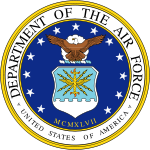Air Force One
| Air Force One | |
|---|---|
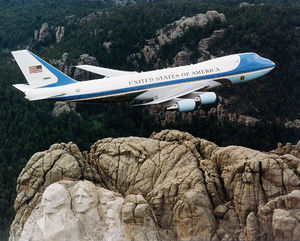 |
|
| SAM 28000, one of the two VC-25s used as Air Force One, above Mount Rushmore |
Air Force One is the official air traffic control call sign of any United States Air Force aircraft carrying the President of the United States.[1] Since 1990, the presidential fleet has consisted of two specifically configured, highly customized Boeing 747-200B series aircraft with serial numbers "28000" and "29000"—with Air Force designation "VC-25A". While these aircraft have the call sign "Air Force One" only while the president is on board, the term is still used colloquially to describe either of the two aircraft normally used and maintained by the U.S. Air Force solely for the president, as well as any additional Air Force aircraft used by the president.[2]
Air Force One is a prominent symbol of the American presidency and its power.[3] The aircraft are among the most famous and most photographed in the world.[4]
Contents |
History
On October 11, 1910, Theodore Roosevelt became the first U.S. president to fly in an aircraft, although at the time of the flight in an early Wright Flyer from Kinloch Field (near St. Louis, Missouri), he was no longer in office, having been succeeded by William Howard Taft. The record-making occasion was a brief overflight of the crowd at a country fair but was nonetheless, the beginning of presidential air travel.[5]
Prior to World War II, overseas and cross-country presidential travel was rare. Lack of wireless telecommunication and quick transportation made long-distance travel impractical, as it took much time and isolated the president from events in Washington, D.C. By the late 1930s, with the arrival of aircraft such as the Douglas DC-3, increasing numbers of the U.S. public saw passenger air travel as a reasonable mode of transportation. All-metal aircraft, more reliable engines, and new radio aids to navigation had made commercial airline travel safer and more convenient. Life insurance companies even began to offer airline pilots insurance policies, albeit at extravagant rates, and many commercial travelers and government officials began using the airlines in preference to rail travel, especially for longer trips.
Franklin D. Roosevelt was the first president to fly in an aircraft while in office. During World War II, Roosevelt traveled on the Dixie Clipper, a Pan Am-crewed Boeing 314 flying boat to the 1943 Casablanca Conference, in Morocco, a flight that covered 5,500 miles (in three "legs").[6] The threat from the German submarines throughout the Battle of the Atlantic made transatlantic air travel the preferred method of transportation.[7]
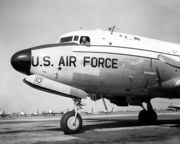
Concerned about relying upon commercial airlines to transport the president, USAAF leaders ordered the conversion of a military aircraft to accommodate the special needs of the Commander in Chief.[8] The first dedicated aircraft proposed for presidential use was a C-87A VIP transport aircraft. This aircraft, number 41-24159, was re-modified in 1943 for use as a presidential VIP transport, the Guess Where II, intended to carry President Franklin D. Roosevelt on international trips.[9] Had it been accepted, it would have been the first aircraft to be used in presidential service, in effect the first Air Force One. However, after a review of the C-87's highly controversial safety record in service, the Secret Service flatly refused to approve the Guess Where II for presidential carriage.[9] The aircraft was then used to transport senior members of the Roosevelt administration on various trips. In March 1944, the Guess Where II transported Eleanor Roosevelt on a goodwill tour of several Latin American countries. The C-87 was scrapped in 1945.[9]
The Secret Service subsequently reconfigured a Douglas C-54 Skymaster for duty as a presidential transport. This VC-54C aircraft, nicknamed the Sacred Cow, included a sleeping area, radio telephone, and retractable elevator to discreetly lift Roosevelt in his wheelchair. As modified, the VC-54C was used by President Roosevelt only once, on his trip to the Yalta Conference in February 1945. The first official flight of Air Force One was in 1959 during the Eisenhower administration.[8]
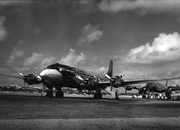
After Roosevelt died in spring 1945, Vice President Harry S. Truman became President. The legislation that created the U.S. Air Force, the National Security Act of 1947, was signed by Truman while onboard the VC-54C.[8] He replaced the VC-54C in 1947 with a modified C-118 Liftmaster, calling it the Independence (also the name of Truman's hometown in Missouri). This was the first aircraft acting as Air Force One that had a distinctive exterior–a bald eagle head painted on its nose.
The presidential call sign was established for security purposes during the administration of Dwight D. Eisenhower. The change stemmed from a 1953 incident where an Eastern Airlines commercial flight (8610) had the same call sign as a flight the president was on (Air Force 8610). The aircraft accidentally entered the same airspace, and after the incident the unique call sign "Air Force One" was introduced for the presidential aircraft.
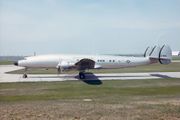
Eisenhower also introduced four other propeller aircraft, the Lockheed C-121 Constellations (VC-121E) to presidential service. These aircraft were named Columbine II and Columbine III by Mamie Eisenhower after the columbine, the official state flower of Colorado, her adopted home state. Two Aero Commanders were also added to the fleet and earned the distinction of being the smallest planes ever to serve as Air Force One. President Eisenhower also upgraded Air Force One's technology by adding an air-to-ground telephone and an air-to-ground teletype machine.
Boeing 707s
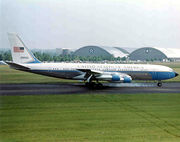
Towards the end of Eisenhower's term in 1958, the Air Force added three Boeing 707 jets (as VC-137s designated SAM 970, 971, and 972), into the fleet. Eisenhower became the first president to use the VC-137 during his "Flight to Peace" Goodwill tour, from 3 December through 22 December 1959. He visited 11 Asian nations, flying 22,000 miles (35,000 km) in 19 days, about twice as fast as he would have on Columbine.
In October 1962, the John F. Kennedy administration purchased a C-137 Stratoliner, a modified long-range 707—Special Air Mission (SAM) 26000, although he had used the Eisenhower-era jets for trips to Canada, France, Austria and the United Kingdom.
The Air Force had attempted a special presidential livery of their own design: a scheme in red and metallic gold, with the nation's name in block letters. Kennedy felt the aircraft appeared too regal, and, on advice from his wife, First Lady Jacqueline Kennedy, he contacted the French-born American industrial designer Raymond Loewy for help in designing a new livery and interiors for the VC-137 jet.[3] Loewy met with the president, and his earliest research on the project took him to the National Archives, where he looked at the first printed copy of the United States Declaration of Independence, and saw the country's name set widely spaced and in upper case in a typeface called Caslon. He chose to expose the polished aluminum fuselage on the bottom side, and used two blues; a slate-blue associated with the early republic and the presidency, and a more contemporary cyan to represent the present and future. The presidential seal was added to both sides of the fuselage near the nose, a large American flag was painted on the tail, and the sides of the aircraft read "United States of America" in all capital letters. Loewy's work won immediate praise from the president and the press. The VC-137 markings were adapted for the larger VC-25 when it entered service in 1990.[10]

SAM 26000 was in service from 1962 to 1998, serving Presidents Kennedy to Clinton. On November 22, 1963, SAM 26000 carried President Kennedy to Dallas, Texas, where it served as the backdrop as President and Mrs. Kennedy greeted well-wishers at Dallas' Love Field. Later that afternoon, Kennedy was assassinated, and Vice President Lyndon Johnson assumed the job of president and took the oath of office aboard SAM 26000. At Johnson's request, the plane carried Kennedy's body back to Washington. It also flew over Arlington National Cemetery as Kennedy was being laid to rest, following 50 fighter jets. A decade later, it brought Johnson's own body to Washington for his state funeral and then back home to Texas. As the former president was laid to rest at his ranch, a former pilot of SAM 26000 presented the flag to Lady Bird Johnson.
SAM 26000 was replaced in 1972 by another VC-137, Special Air Mission 27000, although SAM 26000 was kept as a backup until it was finally retired in 1998. SAM 26000 is now on display at the National Museum of the United States Air Force. Richard Nixon was the first president to use SAM 27000, and the newer aircraft served every president until it was replaced by two VC-25 aircraft (SAM 28000 and 29000) in 1990. After announcing his intention to resign, Nixon boarded SAM 27000 to travel to California. Over Missouri, the call sign for the airplane changed from Air Force One to SAM 27000 after Gerald Ford became president.
SAM 27000 was decommissioned in 2001 by President George W. Bush, flown to San Bernardino International Airport in California, and later dismantled and taken to the Ronald Reagan Presidential Library in Simi Valley, where it was reassembled and is currently on permanent display.
Boeing 747s
Though Ronald Reagan's two terms as president saw no major changes to Air Force One, the manufacture of the current 747s began during his presidency. The USAF issued a Request For Proposal in 1985 for two wide-bodied aircraft with a minimum of three engines and an unrefueled range of 6000 miles. Boeing with the 747 and McDonnell Douglas with the DC-10 submitted proposals, and the Reagan Administration ordered two identical 747s to replace the aging 707s he used.[11] The interior designs were drawn up by First Lady Nancy Reagan, and were reminiscent of the American Southwest.[11] The first aircraft was delivered in 1990, during the administration of George H. W. Bush. Delays were experienced to allow for additional work to protect the aircraft from electromagnetic pulse (EMP) effects.
The VC-25 is equipped with both secure and unsecure phone and computer communications systems, enabling the president to perform duties while in the air in the event of an attack on the United States.
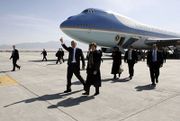
The presidential air fleet is maintained by the 89th Airlift Wing at Andrews Air Force Base, Maryland.
Air Force One usually does not have fighter aircraft to escort the presidential aircraft over the United States, but this has occurred. In June 1974, while President Nixon was on his way to a scheduled stop in Syria, Syrian fighter jets intercepted Air Force One to act as escorts. However, the Air Force One crew was not informed in advance and, as a result, took evasive action including a dive.[12]
One of the most dramatic episodes aboard Air Force One happened during the September 11 attacks. President George W. Bush was interrupted at Emma E. Booker Elementary School in Sarasota, Florida after the attack on the World Trade Center South Tower in New York City. He flew on a VC-25 from Sarasota-Bradenton International Airport to Barksdale Air Force Base in Louisiana and then to Offutt Air Force Base in Nebraska before returning to Washington. The next day, officials at the White House and the Justice Department explained that President Bush did this because there was "specific and credible information that the White House and Air Force One were also intended targets."[13] The White House later could not confirm evidence of a threat made against Air Force One, and subsequent investigation found the original claim to be a result of miscommunication.[14]
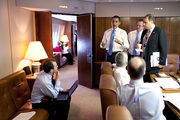
When President Bush came to the end of his second term in 2009, a VC-25 was used to transport him to Texas. For this purpose the craft was called Special Air Mission 28000, as the aircraft did not carry the current President of the United States. Similar arrangements were made for ex-Presidents Ronald Reagan and Bill Clinton.
On April 27, 2009, a low-flying VC-25 circled New York City for a photo-op and training exercise and caused a scare for many in New York.[15] Fallout from the photo op incident led to the resignation of the director of the White House Military Office.
The VC-25As are expected to be replaced, as they have become less cost-effective to operate. The USAF Air Mobility Command has been charged with looking into possible replacements, including the new Boeing 747-8 and the EADS Airbus A380.[16] On January 7, 2009, the USAF Air Materiel Command issued a new requirement for a replacement aircraft to enter service beginning in 2017.[17] On January 28, 2009, EADS announced they would not bid on the program, leaving Boeing the sole bidder, with either their Boeing 747-8 or Boeing 787 being proposed.[18]
Other presidential aircraft
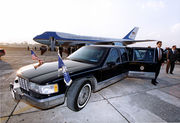
United Airlines was the only commercial airline to have operated Executive One, the designation given to a civilian flight on which the U.S. President is aboard. On December 26, 1973, then-President Richard Nixon flew as a passenger aboard a Washington Dulles to Los Angeles International flight. It was explained by his staff that this was done in order to conserve fuel by not having to fly the usual Boeing 707 Air Force aircraft.[20]
On March 8, 2000, President Bill Clinton flew to Pakistan aboard an unmarked Gulfstream III while another aircraft with the call sign "Air Force One" flew on the same route a few minutes later. This diversion was reported by several U.S. press outlets.[21][22][23]
In May 2009, President Barack Obama took the first lady on a date to New York City in a Gulfstream 500.[24] On July 16, 2010, the Obama family flew to Maine for vacation in a Gulfstream III painted in presidential colors.[25]
The president also flies in Marine One helicopters operated by the US Marine Corps.
Air Force One aircraft on display
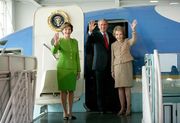
Several presidential aircraft that have formerly served as Air Force One (Sacred Cow, Independence, Columbine III, SAM 26000, and other smaller presidential aircraft) are on display in the presidential hangar of the National Museum of the United States Air Force (located at Wright-Patterson AFB near Dayton, Ohio) and at the Museum of Flight in Seattle, Washington (earlier VC-137B SAM 970). The Boeing 707 that served as Air Force One from the Nixon years through the George H. W. Bush administration (SAM 27000) is on display in Simi Valley, California at the Ronald Reagan Presidential Library. The library's Air Force One Pavilion was opened to the public on October 24, 2005.
A VC-118A Liftmaster used by John F. Kennedy is on display at the Pima Air & Space Museum in Tucson, Arizona.
Roster of previous presidential pilots
Lt. Col. Henry T. Myers:[26]
- President Franklin Roosevelt: June 1944-April 1945
- President Harry Truman: April 1945-January 1948
Col. Francis W. Williams:[26]
- President Harry Truman: January 1948-January 1953
Col. William G. Draper:[26]
- President Dwight Eisenhower: January 1953-January 1961
Col. James Swindal:[26]
- President John F. Kennedy: January 1961-November 1963
- President Lyndon Johnson: November 1963-July 1965
Col. James V. Cross:[26]
- President Lyndon Johnson: July 1965-May 1968
Lt. Col. Paul Thornhill:[26]
- President Lyndon Johnson: May 1968-January 1969
Col. Ralph D. Albertazzie:[26]
- President Richard Nixon: January 1969-August 1974
Col. Lester C. McClelland:[26]
- President Gerald Ford: August 1974-January 1977
- President Jimmy Carter: January 1977-April 1980
Col. Robert E. Ruddick:[26]
- President Jimmy Carter: April 1980-January 1981
Lt.Col. Richard J. Klinker:[26]
- President Ronald Reagan: January 1981-January 1989
Col. Robert D. “Danny” Barr:[26]
- President George H. W. Bush: January 1989-January 1993
- President Bill Clinton: January 1993-January 1997
Col. Mark S. Donnelly:[27]
- President Bill Clinton: January 1997-January 2001
- President George W. Bush: January 2001-June 2001
Col. Mark W. Tillman:[27]
- President George W. Bush: June 2001-January 2009
Col. Scott Turner:[28]
- President Barack Obama: January 2009–present
See also
- Air Force One photo op incident
- Air Force Two
- Air transports of heads of state and government
- Boeing C-32
References
- Notes
- ↑ Order 7110.65R (Air Traffic Control) Federal Aviation Administration 14 March 2007. Retrieved: 27 August 2007.
- ↑ Bosman, Julie. "Politics Can Wait: The President Has a Date." The New York Times, May 30, 2009. Retrieved: June 17, 2009.
- ↑ 3.0 3.1 Walsh 2003.
- ↑ Wallace, Chris (host). "Aboard Air Force One." Fox News, November 24, 2008. Retrieved: November 28, 2008.
- ↑ Hardesty 2003, pp. 31–32.
- ↑ Hardesty 2003, p. 38.
- ↑ Hardesty 2003, p. 39.
- ↑ 8.0 8.1 8.2 "Factsheet: Douglas VC-54C SACRED COW". National Museum of US Air Force. Retrieved: October 19, 2009.
- ↑ 9.0 9.1 9.2 Dorr 2002, p. l34.
- ↑ Hardesty 2003, p. 70.
- ↑ 11.0 11.1 Williams, Rudi. "Reagan Makes First, Last Flight in Jet He Ordered." United States Department of Defense. June 10, 2004. Retrieved: June 23, 2009.
- ↑ "Washington Post Online conversation with Kenneth Walsh on his Air Force One: A History of the Presidents and Their Planes". washingtonpost.com, May 22, 2002. Retrieved: October 18, 2009.
- ↑ "Press Briefing by Ari Fleischer." White House News releases, September 2001. Retrieved: October 18, 2009.
- ↑ Allen, Mike. "White House Drops Claim of Threat to Bush." The Washington Post, p. A08, September 27, 2001. Retrieved: February 28, 2007.
- ↑ Rao, Mythili and Ed Henry. " 'Furious' Obama orders review of NY plane flyover." cnn.com, April 28, 2009. Retrieved: October 18, 2009.
- ↑ Trimble, Stephen. "US considers Airbus A380 as Air Force One and potentially a C-5 replacement." Flight Global, October 17, 2007. Retrieved: June 23, 2009.
- ↑ Horine, Daniel. "USAF Presidential Aircraft Recapitalization (PAR) Program." USAF Materiel Command, 7 January 2007. Retrieved: 8 January 2009.
- ↑ Butler, Amy. "Boeing Only Contender for New Air Force One". AviationWeek.com, January 28, 2009. Retrieved: June 23, 2009.
- ↑ "Homeland Security Budget-in-Brief Fiscal Year 2009". United States Department of Homeland Security. 2009. pp. 109. http://www.dhs.gov/xlibrary/assets/budget_bib-fy2009.pdf. Retrieved 31 January 2010.
- ↑ Mudd, Roger and Richard Wagner. Vanderbilt Television News Archive "President / Commercial Airline Flight." CBS News, December 27, 1973. Retrieved: June 23, 2009.
- ↑ Sammon, Bill. "Clinton uses decoy flight for security." Washington Times, March 26, 2000, p. C.1.
- ↑ Haniffa, Aziz. "Playing hide-and-seek on trip to Islamabad." India Abroad. New York: March 31, 2000, Vol. XXX, Issue 27, p. 22.
- ↑ "Clinton's trip to Asia cost at least $50 million." Milwaukee Journal Sentinel, April 9, 2000, p. 175 A.
- ↑ Hurt, Charles and Stefanie Cohen. Barack Obama takes Michelle on NYC Date. May 30, 2009. Retrieved May 22, 2010.
- ↑ Metzler, Rebekah (16 July 2010). "Obama arrives for MDI vacation". Portland Press Herald. http://www.pressherald.com/news/Media-dignitaries-await-presidents-arrival.html. Retrieved 16 July 2010.
- ↑ 26.00 26.01 26.02 26.03 26.04 26.05 26.06 26.07 26.08 26.09 26.10 Long, Major Timothy A., USAF. "The Diplomatic Drawing Power of Air Force One and Its Effect on the Tactical and Strategic Levels of Diplomacy. (Research Report)" Maxwell AFB, Alabama: Air University, April 2008.
- ↑ 27.0 27.1 Dorr 2002
- ↑ "Air Force One pilot set for final mission." Air Force Times Staff Report, January 19, 2009.
- Bibliography
- Abbott James A. and Elaine M. Rice. Designing Camelot: The Kennedy White House Restoration. New York: Van Nostrand Reinhold, 1998. ISBN 0-442-02532-7.
- Albertazzie, Ralph and Jerald F. TerHorst. Flying White House: The Story of Air Force One. New York: Coward, McCann & Geoghegan, 1979. ISBN 0-698-10930-9.
- Braun, David. "Q&A: U.S. Presidential Jet Air Force One." National Geographic News, May 29, 2003.
- Dorr, Robert F. Air Force One. St. Paul, Minnesota: Motorbooks International, 2002. ISBN 0-7603-1055-6.
- Hardesty, Von. Air Force One: The Aircraft that Shaped the Modern Presidency. Chanhassen, Minnesota: Northword Press, 2003. ISBN 1-55971-894-3.
- Harris, Tom. "How Air Force One Works." HowStuffWorks.com. Retrieved: October 10, 2006.
- Walsh, Kenneth T. Air Force One: A History of the Presidents and Their Planes. New York: Hyperion, 2003. ISBN 1-4013-0004-9.
External links
- SAM 26000 at the National Museum of the United States Air Force
- White House Museum Air Force One Page - Facts, historic photos, and models
- Facts and History of 707 as Air Force One and "Where they are Now?"
- Air Force One Pavilion
- Air Force Fact Sheet, VC-25 - AIR FORCE ONE
- Air Force One page on White House site
- Truman Library & Museum
- United States Air Force
- Boeing History of Air Force One
- Technical Order 00-105E-9, Segment 9, Chapter 7
|
|||||||||||||||||||||||||||||||||||||||||||||||||||||||||||||
